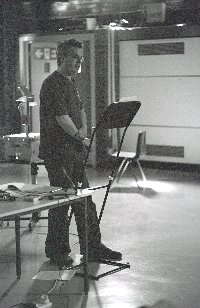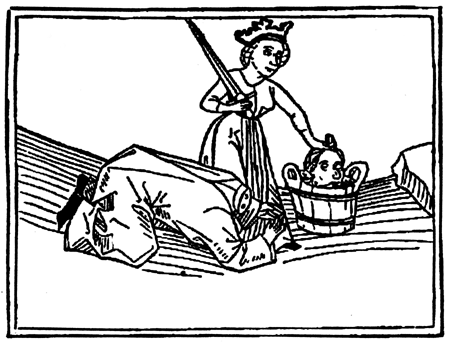 Virtuosity and Performance
Mastery issue, 2003/04
Virtuosity and Performance
Mastery issue, 2003/04
THE OBSIDIAN MIRROR - A TRUE AND FAITHFUL ACCOUNT OF WHAT PASSED FOR MANY YEARS…
Copyright © Kit Poulson 2003.
(No part of this text may be reproduced without the written permission of the author.)

This material was presented live at the Virtuosity and Performance Mastery symposium for postgraduate/research degree students and academic staff over two days by Performing Arts at Middlesex University on 31st May and 1st June 2003.
I will begin with an image.
A book lined room, curtains drawn though it is daylight outside.
Scattered objects indicate the gradual encroachment of practical disorder due to some sustained activity that allows no pause for mundane tasks.
At the centre of the room there is a table upon which lays a thin slab of dark stone.
The door is locked.
Two people are in the room, dressed as you would expect learned people to be, with a certain scruffy dignity.
One is looking intently at the other, as if interrogating every aspect of his person. The second man looks only at the slab, he is somewhat dishevelled, perhaps even distressed, in the groundswell of some strong emotion.
I half formed this picture when I saw the stone slab at the Welcome trust Museum, about seven years ago.

It was described as an obsidian mirror originally of Aztec manufacture, which Dr John Dee, undoubtedly one of the most educated men in Elizabethan England, had used in his attempts to converse with angels.
The immediate historical reaction to such information is to compartmentalise- obviously Dee had a certain eccentric obsession, certain slightly unhinged views that should not colour our view of him as a mathmatician, a navigator, a scientist, a designer of stage effects.
But what if give him the benefit of the doubt?
I don't want to propose we discuss Dees personal faith in the supercelestial realm, but rather to look at the way he set about to exploring his faith, to questioning his knowledge.
Back to the room

One of the people is John Dee, he is intently examining Edward Kelly a scryer or medium.
 For three days before the
participants rigourously prepared mentally, ate certain foods, shaved their beards abstained
from the carnal. They have undergone 'dignification'
For three days before the
participants rigourously prepared mentally, ate certain foods, shaved their beards abstained
from the carnal. They have undergone 'dignification'
Dee has been asking a long series of detailed questions and carefully annotating all that is said. Kelly meanwhile has been staring into the stone, the showplate, and describing the visions he sees, he seems to adopt different voices and personas, young girls, old men and angels. Occasionally he rails against himself decrying a demon of attempting to dissimulate itself into their discourse. At no point does Dr Dee claim to see any thing.
The artifacts in the room were carefully positioned. Special tables of figures were prepared Previous results were analysed and reference works prepared for consultation.
The sessions took place over many years.
Dees research project was to use these sessions to learn the original God given language of Adam and Eve, before it was corrupted by the fall. This would bring a unity to the array of his knowledge and bring an end to the viscious religious divisions of his day.
Perhaps Kellyís was, or felt he was, gifted with second sight; or perhaps he wanted to fulfil Dee's deepest desires, to perform the task that was asked of him. Then again perhaps he was a complete fraud. Yet the persistance of the undertaking demands at least we recogonise certain degrees of virtousity within it.
If nothing else the sessions must be seen as highly impressive acts of joint improvisation, a interweaving of desire and fulfillment , of leading and being lead.
The image of this strange set up keeps reoccuring to me as I begin to think about aspects of my engagement with research. The combination of delight and wariness is familiar, if I learn this new language will I betray what I hold dear
There is something that fascinates me about the relationship between the protagonists, and how it is grounded upon the unyielding surface of a stone mirror.
The object does not speak, we reflect our speech from it, I have not seen Dee or Kelly nor spoken to them, but I have seen the mirror. I did not converse with any angels. Dee and Kelly, not subject or object, but projections of self.
I have produced my own objects, works that I have decide to finish, and displayed to an audience They have separated from me, and left me a passionate spectator.

What happens next? are they faithful conveyances of my creative moment or do they begin to transmit beyond my control.
Perhaps if we look at the room as the model of a studio, the work is being made and analysed at the same time. We are performing a kind of exegesis on the levels of technique, history, politics and psychology - yet the work remains a unity it doesn't become 'a conglomeration of things' but remains itself and is separate from us. In investigating technique you bring yourself to a limit, an edge of understanding, which calls you take a further step yourself, yet you therefore also abandon your guidelines and rather than stepping into freedom you fold back upon yourself.
The duration of the object manufactured has been squeezed almost to the point of invisibility, yet its traces are left all around. It becomes a catalyst for transformation of all our knowledge
 Sometimes I am frustrated by the
silence of my painting so I attempt to give it voice, yet find that now I have two problems,
an engagement with live work and with painting, both seemingly drifting away from my rational
intellect, although feeding into each other. At other times I delight in paintings silence
and want to shape objects that spin great silences from within themselves… silent
painting, silent painter, silent viewer, less and less and less.
Sometimes I am frustrated by the
silence of my painting so I attempt to give it voice, yet find that now I have two problems,
an engagement with live work and with painting, both seemingly drifting away from my rational
intellect, although feeding into each other. At other times I delight in paintings silence
and want to shape objects that spin great silences from within themselves… silent
painting, silent painter, silent viewer, less and less and less.
Yet I desire to communicate
I enjoy reading but am anxious about writing. I have many opinions, I am creative- If I do not like what is written I begin to wonder what I would write about my work.. How can I begin to write and who do I write for.
A key part in this relationship is the tension between a store of gathered knowledge and a yearning for a different means of understanding what you possess, or in fact only partially possess, for knowing constantly eludes you. This might be a process within the creation of a painting, a step you need to take to bypass the impasse of a cliché , the elimination of a colour, one less or more mark - yet it could equally well be a commitment to attempt to learn a new discipline, to step outside of an area in which you feel confident and into one where you are exposed, perhaps most of all to your own judgement, your own ideas about what is fitting and right . And doubt is constantly present, but this only serves to illuminate a fundamental basis of trust that is at the core of the exchange.
Rather than a linear march towards a research objective can we also propose the creation of a fixed space which allows work to emerge?
This space is constructed physically as an area of development and experiment, temporally as a period of time during which this exploration can take place, and also emotionally, in the feeling of a kind of permission to exist as an artist

Perhaps it is a function of a certain kind of seriousnesss that attachs to a research project, a feeling of authority of decision. I do not think that this is a small thing in a time in which many artists feel that they are of a marginal importance to society.

This is something that needs to be valued but is hard to communicate, save through direct experience, I feel one kind of research has to be a documentation of the day to day practice, a documentation which would allow others into the creative space that has been formed.

The further question would then be how do you value your own work? Why have I sought to undertake a research degree? What do I want from it, what obligation do I owe?

I think I am engaging in an exercise of desire.
And I am exposed to a judgement beyond myself.




Kit Poulson defines the core of his practice as painting although he also produces installation and live pieces, often in collaboration (with other artists, dancers and musicians). Before studying fine art at Middlesex University he has had experience working in the theatre and completed a degree in History at Edinburgh University.
All images copyright © Kit Poulson.
Web design copyright © John Robinson, 2004.
Last updated 30th August 2004.